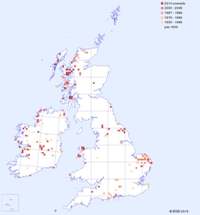The Narrow-leaved Marsh-orchid, also known as Pugsley's Marsh-orchid, is endemic to Britain and Ireland, where it occurs in just a few localised sites. Because of the ease with which it hybridises, this orchid is one of the most difficult species to identify with certainty. In Scotland the situation is further complicated by the presence of the Lapland Orchid, currently treated as a subspecies Dactylorhiza traunsteinerioides subsp. lapponica which is also very localised and differs from the plants described below in having very darkly coloured spots and circles on the upper surfaces of the leaves, and flower lips with very dark, almost crimson, rings, lines and spots. Narrow-leaved Marsh-orchid is found in very specific habitats; it requires very wet, base-rich conditions influenced by the presence of limestone or chalk. Only in Scotland does the subspecies lapponica stray into the fringes of slightly more acidic, but still very wet, heathland. The flowering time depends upon the plants' geographical location: those in the south and west flower in May, but those in the north don't usually begin flowering until late June and can still be found in flower in late July. Wales is one of the strongholds of this orchid. It is well known from Anglesey and the Llŷn Peninsula in the north, and from Borth Bog further south. There are scattered sites in England; in Scotland the Narrow-leaved Marsh-orchid appears in localised sites, often keeping company with the subspecies lapponica; and in Ireland it is more common in the south west, while there are just a few known sites in Northern Ireland. In Scandinavia, Dactylorhiza traunsteinerioides is replaced by Dactylorhiza lapponica, which is described as a distinct species.
| Distribution Map | Key Features | |
 |
Records for the Narrow-leaved Marsh-orchid from BSBI are shown on the map with most recent in front. (Hover the mouse over the small map to expand it.) |
Plant: 6 to 40cm tall; stem green, purple towards the tip, very fragile and somewhat wavy in shape. |
Image Gallery for Narrow-leaved Marsh-orchid Dactylorhiza traunsteinerioides
| Pollination | Taxonomy & Hybrids |
Little is known, but it is likely that pollination is carried out by bees and other insects. Vegetative reproduction may be viable. |
The specific name traunsteinerioides honours an Austrian pharmacist, Joseph Traunsteiner. |
Articles about Narrow-leaved Marsh-orchid in JHOS
